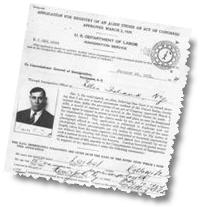Registry Files, March 2, 1929-March 31, 1944

Registry Files document the creation of official immigrant arrival records under the Registry Act of March 2, 1929 (45 Stat 1512), which applied to persons who entered the United States prior to July 1, 1924, and for whom no arrival record could later be found.
Background
The Basic Naturalization Act of 1906 first required a record of lawful entry/admission as a prerequisite to naturalization. The effect of the new law became apparent five years later, in 1911, when numerous immigrants were unable to naturalize because there was no record of their admission, or no such record could be found. These people could not naturalize until Congress provided relief with the Registry Act of 1929.
Registry Files document the first “legalization program” authorized by Congress. The law and program allowed immigrants subject to the Certificate of Arrival requirement for naturalization, but for whom no arrival record could be found, to have a record of their original arrival created. Though dating after 1929 the records actually relate to immigrant arrivals occurring many years before. Registry Files from 1929 to 1944 generally relate to immigrant arrivals between June 29, 1906 and July 1, 1924. The initial Registry program applied to immigrants who arrived before July 1, 1921. Later, as time passed, Congress moved the ending date progressively forward.
Immigrants applied for Registry through their local District Office where officers investigated, took testimony, and compiled evidence. The record was then forwarded to Washington with a recommendation as to whether or not Registry should be granted.
The Files Today
Registry Files survive in their original paper form. They contain applications, testimony, evidence, correspondence, a photo, and a decision granting or denying Registry. They are arranged by Registry File Number (i.e., R-#####) and indexed by name and number.
Research Value
Registry Files are treasures for the few genealogists whose immigrant ancestors who applied (there are only about 1/4 million Registry Files). The Registry application is full of dates, places, and names, an account of the immigrant's travel to the United States as well as accounting for their activities (employment, residence) since arrival. In addition to the application the files typically hold correspondence, affidavits, testimony, and other related papers. Documentary evidence can include school records, insurance receipts, rental agreements, or anything establishing the immigrant's residence prior to July 1, 1924.
Index Search Issues
Because index entries for Registry Files contain only names and file numbers, and lack any information as to date and place of birth, it is often difficult to match a subject to a Registry File. This situation is often compounded by the fact that most immigrants underwent Registry proceedings so they might naturalize, yet their C-File index card makes no mention of the Registry or Registry File number. Successful searches will contain at least one alternate name, a date of birth, and the immigrant’s place of residence when he/she applied for Registry between 1929 and 1944.
Record Request Issues
There are few record request issues related to retrieval of Registry Files. In some cases a Registry File was consolidated into an A-File or C-File after 1944. If so, the Genealogy Program will provide the A-File or C-File for the fee already paid.
Registry Files may include documents containing personal information about other persons (called "third parties") who may still be living, such as the immigrant's children, other family, or neighbors. A document containing third party personal information is not releasable outside the Freedom of Information (FOIA) process, so some records recieved from the Genealogy Program may have some information redacted.
Where do I find a Registry File number?
Registry File numbers are rarely found without a Genealogy Index Search Request. However, some R-numbers will be found on land border port card manifests now available on National Archives microfilm publications. In some cases researchers will find hints suggesting the existence of a Registry File in other immigration or naturalization documents:
-
If a Petition for Naturalization is 1) granted after March 1929, and 2) indicates arrival after June 30, 1906, 3) aboard the “SS Unknown” or at an “unknown” port of entry, then the immigrant may have undergone Registry.
-
If the Certificate of Arrival number shown on a Petition for Naturalization granted after March 1929 includes a letter “R” (i.e., ##-R-#####), the immigrant likely underwent Registry.
-
If an index card on the Index (Soundex) to Passenger Lists of Vessels Arriving at New York, NY, July 1, 1902--December 31, 1943 (National Archives publication T621) does not reference a steamship arrival but instead contains reference to a Certificate of Registry number (i.e., CR-#####), the immigrant likely underwent Registry. Note the CR-number is not the Registry File number (R-number) needed to submit a Genealogy Record Request.